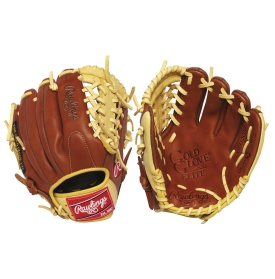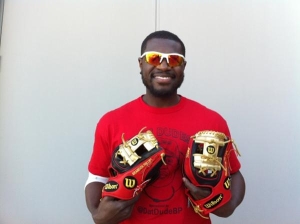 Gold Glove Trademark Battle
Gold Glove Trademark Battle
If you’re a baseball fan, you’re familiar with Rawlings Gold Glove Award, an award given to various players for their defensive excellence. What you may not know is that Rawlings Sporting Goods owns U.S. trademark registrations for several marks including GOLD GLOVE and GOLD GLOVE AWARD. Rawlings is serious about enforcing their rights against any competitors. In July, Rawlings filed a lawsuit against Wilson Sporting Goods for trademark infringement, trademark dilution, and false advertising, as well as a few state law claims, in connection with its Gold Glove trademarks. In its complaint, Rawlings claimed that Wilson produced baseball gloves with gold colored webbing and published images of the glove in its promotional materials. While both Rawlings and Wilson manufacture and sell baseball gloves, the specific issue here relates to the gold colored webbing, stitching and lettering.
Where does the famous Rawlings Gold Glove come from, and do they have the ability to enforce trademark rights against anyone who uses the color gold on baseball gloves?
Gold Glove History
The Gold Glove was an award created in 1957 by Rawlings. The award is given annually to one player at each position in both the National League and in the American League for their talent and successive in their respective defensive positions. Along with a formal award, recipients are given a Rawlings baseball glove to use on the field. These gloves have distinctive gold webbing, stitching, and markings.
 Brandon Phillips, a second baseman for the Cincinnati Reds, won the Gold Glove Award in 2008, 2010, and 2011. Phillips has a contract with Wilson to endorse and use their products on the field. Rawlings’ complaint states that Brandon Phillips was given a glove from Wilson that has gold webbing and stitching and is “confusingly similar” (hint: that’s key trademark terminology) to the Rawlings Gold Glove. Rawlings claims that Wilson is diluting the distinctiveness of Rawling’s brand image and weakening the public’s ability to identify and associate the trademark with Rawlings’ sporting equipment. The complaint states that consumers are well aware of the connection between the trademarks and Rawlings, not only due to the fame of the award, but through Rawlings’ use of the trademark on their own products. This use includes miniature replica Gold Glove awards and a Gold Glove line of leather baseball gloves. It is not clear, however, if Wilson is selling, or plans to sell, the allegedly infringing gloves to the public.
Brandon Phillips, a second baseman for the Cincinnati Reds, won the Gold Glove Award in 2008, 2010, and 2011. Phillips has a contract with Wilson to endorse and use their products on the field. Rawlings’ complaint states that Brandon Phillips was given a glove from Wilson that has gold webbing and stitching and is “confusingly similar” (hint: that’s key trademark terminology) to the Rawlings Gold Glove. Rawlings claims that Wilson is diluting the distinctiveness of Rawling’s brand image and weakening the public’s ability to identify and associate the trademark with Rawlings’ sporting equipment. The complaint states that consumers are well aware of the connection between the trademarks and Rawlings, not only due to the fame of the award, but through Rawlings’ use of the trademark on their own products. This use includes miniature replica Gold Glove awards and a Gold Glove line of leather baseball gloves. It is not clear, however, if Wilson is selling, or plans to sell, the allegedly infringing gloves to the public.
Can a person or business trademark a color?
In Qualitex Co. v. Jacobsen Products Co., Inc., the Supreme Court held that a color can sometimes become a trademark if it meets certain criteria. The color must distinguish a business’s goods and identify the goods’ source, without serving any function, in order to be considered a trademark. In May, I discussed a circumstance in which a color could be a functional feature of a product and, therefore, could not be registered as a trademark. The Supreme Court, in its Qualitex opinion, addressed both “functionality” and “aesthetic functionality” with regard to color. Aesthetic functionality refers to a feature that, if if was to become exclusive through the application of trademark law, would put competitors at a significant non-reputation-related disadvantage. “If (the color) is essential to the use or purpose of the article or it affects the cost or quality of the article,” the Court determined that the color could not be a trademark. When a color is not essential to a product’s use or purpose and does not affect cost or quality or put competitors at a significant non-reputation-related disadvantage, there is not a bar to the use of color alone as a trademark.
To put it another way: a color can be a trademark as long as it:
- Distinguishes the business’s goods.
- Identifies that business of the source of those goods.
…so far, these points appear to be in Rawlings’ favor. Gold as a color on baseball gloves can distinguish Rawlings’ gloves from those of their competitors, and the color gold can identify a glove as a Rawlings products.
- Is not essential to the product’s use or purpose.
…Again, this is in Rawlings’ favor – there is no particular reason why a glove would have to include gold as opposed to any other color.
- Does not affect cost or quality.
…Also in Rawlings’ favor. Wilson is not disadvantaged in terms of cost or quality by having to chose a color other than gold.
- Does not put competitors at a significant non-reputation-related disadvantage.
…This point is a bit more complicated, but it seems to favor Rawlings as well. If the case goes to court, and the decision ends up granting Rawlings exclusive use of the color gold in connection with baseball gloves, Wilson’s only disadvantage will be reputational. There is no reason, other than the commercial reputation associated with famous “Gold Glove” award, that Wilson or any other manufacturer would choose to use gold as a color on a baseball glove. It looks like Rawlings has a strong case, and I’ll be willing to bet that Wilson will move on to some other color sooner or later.

